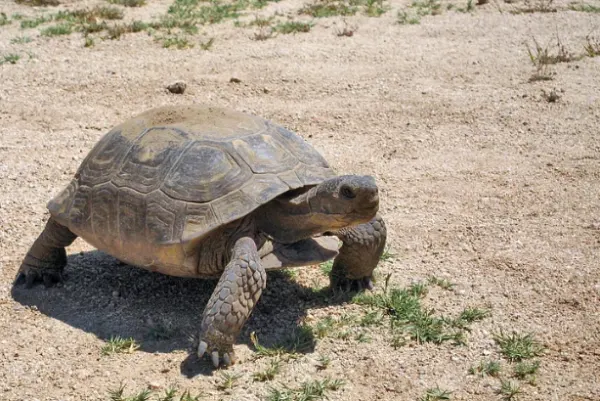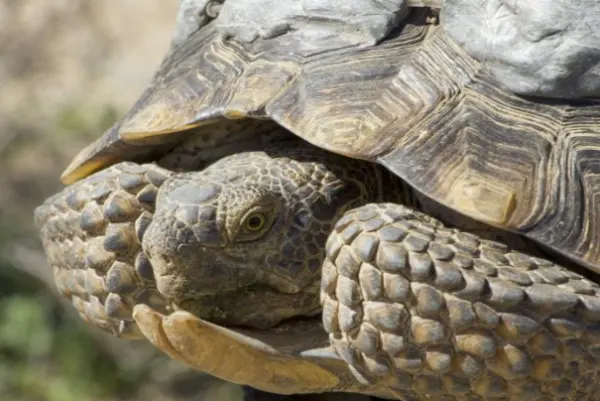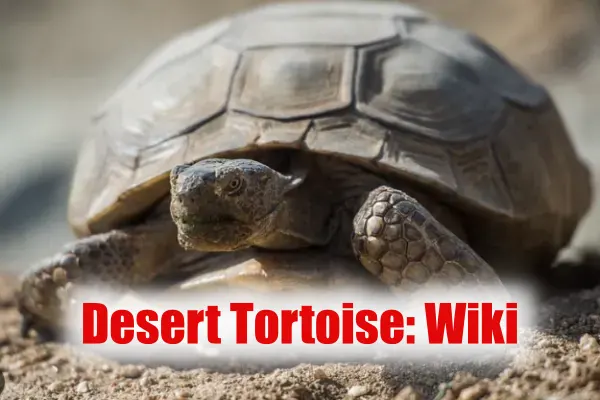Hey there, let’s play a game. I will take the name of an animal, and you have to tell me about its basic characteristics. Are you ready? So tell me something about tortoises. You may say a shell is a slow walker and likes to live in water. Wait, do you think tortoises only live in water? So here is a species that lives in a place where even humans can’t find water easily. That’s a desert tortoise. Yes, you heard it right.
If you want to know more about it, then stay tuned.
Desert Tortoise: Wiki

Let’s have a look at its ability and character, in short.
| Scientific name | Gopherus agassizii |
| Common name | Desert Tortoise |
| Size | 25-36 cm |
| Habitat | Sandy area and deserts |
| Diet | rice grass, Bermuda grass, ryegrass, primrose, sow thistle, cactus, and wildflowers |
| Predator | coyotes, foxes, bobcats, eagles, and feral dogs |
| Colors | Greenish tan and brown |
| Weight | 8–15 pounds |
| Lifespan | 50–80 years |
| About it | It is a keystone species which have more influence on the ecosystem |
As you observed in the table, the desert tortoise, like other tortoises, is a slow-growing and low-reproductive species.
They like to spend most of their time in burrows, rock shelters, and pallets. The main reason behind this is that they are too conscious to regulate body temperature and reduce water loss, but of course, a tortoise can live without water.
Do you know what makes this tortoise more exciting and increases their body energy? It’s none other than rain. The desert tortoise is most active after seasonal rains; however, it remains inactive during the rest of the year.
The tortoise is observed to live around 50–80 years. Desert tortoises can tolerate water, salt, and energy imbalances, increasing their lifespan.
I. Appearance of Desert Tortoise

Here we are going to look at some basic characteristics and facts of the desert tortoise related to its appearance. First, if we look at the body length of the tortoise, we can find that it can range from 25 to 36 cm. Other than that, the tortoise can grow up to a height of 10–15 cm and weigh 8–15 pounds, as observed.
Now it’s time to talk about its physical appearance. These desert dwellers have long back legs that are skinnier and longer, while the front limbs of the tortoise are sharp and have scales that look like claws, which help them dig. Also, if we are talking about its features, how could we forget about the shell? The shell is a tan-greenish color, which is also seen to have a brown color.
You can easily differentiate males from females, as males are slightly larger than females. Also, Males have a longer gular horn and larger tails.
Discover the captivating world of the Desert Tortoise, a master of survival in the vast and rugged terrain! The secret to their resilience lies in these high domes, which provide ample room for the lungs and aid in thermoregulation.
II. Behavior of Desert Tortoise
Desert tortoises’ activity varies based on their location, peaking in late spring in the Mojave Desert and late summer to fall in the Sonoran Desert. They brumate during the winter, with females bromating later and emerging earlier than males. Temperature significantly influences their activity, with most activity occurring between 26 and 34°C.
Desert tortoises are active during spring and fall, summer, and occasionally warm winter afternoons. Activity generally increases after rainfall. Although most spend their time in shelters, they can move up to 200 meters per day, possibly representing foraging, traveling between burrows, or social behaviors.
III. Habitat of Desert Tortoise

Desert tortoises are keystone species in the southwestern United States and northwestern Mexico, residing in the Mojave and Sonoran deserts. They survive extreme temperatures and low rainfall by going into tunnels during summer and brumation in winter.
They rely on high plant species diversity for food and protection from weather and predators. Desert tortoises can live in areas with ground temperatures exceeding 60°C (140°F) due to their ability to dig burrows and escape the heat.
They create a subterranean environment beneficial to other reptiles, mammals, birds, and invertebrates. Also, they are divided into three species: Agassiz’s, Morafka’s, and Goode’s thorn scrub tortoise.
They inhabit elevations from below sea level in Death Valley to 1,600 m in Arizona, with densities varying from less than 8/km2 in southern California to over 500/km2 in the western Mojave Desert. Moreover, they are sensitive to soil type, preferring sandy loam soils with varying amounts of gravel and clay.
IV. Diet of Desert Tortoise
Desert tortoises eat rice grass, Bermuda grass, ryegrass, primrose, sow thistle, cactus, and wildflowers. They walk slowly across the desert using their scaly feet to pull dry grass out of the ground. They are herbivores, consuming herbs, wildflowers, cacti, fruit, flowers, rocks, and soil.
Water intake comes from moisture in grasses and wildflowers, and they have a large urinary bladder that stores over 40% of their body weight.
Adult tortoises can survive a year or more without access to water but rely on cactus fruits and mesquite grass during summer and dry seasons. Handling them may result in upper respiratory tract infections. Handling them in the wild is not recommended due to potential health risks.
Conclusion:
So here we come to an end. This is a species of tortoise found in the deserts of the United States and the southwestern Mexican deserts. This desert tortoise is really fascinating, and we have learned many things about it now. We are sure that whenever you spot it, you may like to tell your friends and family about it.
However, for today, we concluded our conversation here and will be back with some more interesting facts about interesting animals. Until then, stay tuned to HowItSee.
Frequently Asked Questions:
Q1. Can desert tortoises eat carrots?
Ans. Yes, desert tortoises can eat carrots in moderation. Ensure the carrots are cut into small, manageable pieces to prevent choking, and they should be just one component of a varied diet.
Q2. What should you not feed a desert tortoise?
Ans. Avoid feeding desert tortoises high-protein and high-fat foods, such as animal products and certain vegetables. Stick to a diet rich in leafy greens and vegetables.
Q3. Can desert tortoises eat spinach?
Ans. While spinach contains calcium oxalates that can hinder calcium absorption, offering it occasionally is generally fine. However, it should not be a staple in a desert tortoise’s diet.
Q4. Is cucumber good for desert tortoises?
Ans. Cucumber is a hydrating treat for desert tortoises, but it should be fed in moderation. It’s a good source of water, but it should not replace the main components of their diet.
Q5. Can desert tortoises eat tomatoes?
Ans. Yes, desert tortoises can eat tomatoes in moderation. Remove seeds and excess water content, as too much can cause digestive issues. Tomatoes should complement a well-balanced diet.
Q6. Do desert tortoises hibernate?
Ans. Yes, desert tortoises hibernate. Hibernation is a natural behavior during the colder months when they enter a state of reduced metabolic activity. Provide a suitable hibernation environment if necessary.
Q7. How do I know if my tortoise is hibernating?
Ans. A hibernating tortoise will show reduced activity, and slowed breathing, and may bury itself. Check for responsiveness and consult a veterinarian if unsure. Monitor environmental conditions for proper hibernation.
Q8. What month do tortoises start to hibernate?
Ans. Tortoises typically start to hibernate in late fall or early winter, around October to November, when temperatures drop. Provide a suitable hibernation setup and monitor their behavior accordingly.
Q9. Can you move a hibernating tortoise?
Ans. It’s crucial not to disturb a hibernating tortoise. Moving them can disrupt their hibernation cycle, leading to health issues. Wait until they naturally emerge from hibernation before moving them.
Q10. Backyard desert tortoise habitat ideas?
Ans. Create a backyard desert tortoise habitat with a secure enclosure, proper substrate, hiding spots, and a variety of native plants. Ensure it mimics their natural environment and provides opportunities for basking and burrowing.
Q11. What is the best habitat for a desert tortoise?
Ans. The best habitat for a desert tortoise includes a spacious outdoor enclosure with a mix of sunlight and shade, appropriate substrate, hiding spots, and native vegetation. Mimic their natural environment for optimal well-being.
Q12. How do you create a desert tortoise habitat?
Ans. To create a desert tortoise habitat, choose a sunny location, provide a secure enclosure with proper fencing, use a substrate like soil or coconut coir, offer hiding spots, and include native plants for a natural setting.
Q13. What do I do if I find a desert tortoise in my yard?
Ans. If you find a desert tortoise in your yard, observe from a distance. Do not relocate it unless it’s in immediate danger. If necessary, contact local wildlife authorities for guidance on ensuring its well-being.
Q14. How do I keep tortoises in my backyard?
Ans. Keep tortoises in your backyard by providing a secure outdoor enclosure with proper fencing, suitable substrate, hiding spots, and a balanced diet. Ensure the habitat meets their needs for sunlight, shade, and natural behaviors.
Reference:
- https://en.m.wikipedia.org/wiki/Desert_tortoise
- https://www.nature.org/en-us/get-involved/how-to-help/animals-we-protect/desert-tortoise/
- https://a-z-animals.com/animals/desert-tortoise/
Also Read:

As a content writer, I like to write about different niches. I have a curiosity about nature and animals. And like to learn about them. Through my writing, I like to share my experience and knowledge with you. I hope you are enjoying it too.
